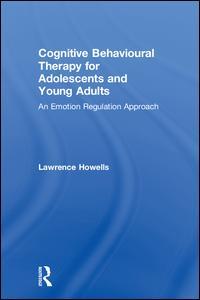Description
Cognitive Behavioural Therapy for Adolescents and Young Adults
An Emotion Regulation Approach
Author: Howells Lawrence
Language: English
Subject for Cognitive Behavioural Therapy for Adolescents and Young...:
Keywords
Pathogen Disgust; cognitive behaviour therapy; Social Anxiety Disorder; young adults; Fear Trap; adolescents; Negative Societal Beliefs; child and adolescent mental health; Blood Injection Injury Phobia; Lawrence Howells; Sexual Intrusive Thoughts; Emotion Regulation Approach; Formal Operational Abilities; Individual’s Early Life; Approach Behaviours; Cultural Display Rules; Hand Brain; Reptilian Brain; Early Adult Development; Clinical Practice; Dysfunctional Assumptions; Emotion Regulation Strategies; Formal Operational Thinkers; Emotion Regulation; Graded Exposure; Diagnostic Model; Emotion Science; Emotion Dysregulation; Interpersonal Threat; Spinal Cord
Publication date: 05-2018
· 15.6x23.4 cm · Hardback
Publication date: 05-2018
· 15.6x23.4 cm · Paperback
Description
/li>Contents
/li>Readership
/li>Biography
/li>
Cognitive Behavioural Therapy for Adolescents and Young Adults: An Emotion Regulation Approach provides a unique focus on therapeutic practice with adolescents and young adults, covering everything from psychological theories of adolescence to the treatment of common emotional difficulties.
Beginning with a review of development through adolescence into adulthood, and the principles of CBT, the book highlights problems with traditional models of CBT for adolescents and young adults. In a fresh approach, this book separates CBT from diagnosis and grounds it instead in emotion science. Adolescents and young adults learn not about disorders and symptoms, but about emotions, emotional ?traps?, and how they can use CBT to bring about change. There are chapters on fear, sadness, anger, emotion dysregulation, and happiness. Each chapter provides an outline of emotion science, a clear cognitive behavioural formulation (?trap?), and evidence-based interventions. Clinicians are walked through the process using case illustrations.
Cognitive Behavioural Therapy for Adolescents and Young Adults represents a transformation of CBT practice, and will become a valuable treatment manual to training and practising mental health professionals, especially psychotherapists specialising in CBT.
Table of Contents
Acknowledgements
Chapter 1: Introduction
Chapter 2: Adolescent development
What and when is adolescence?
Physical development
Brain development
Cognitive development
Social cognitive development
Identity development
Emotion and emotion regulation development
Relations with families and peers
Bringing it all together: theories of adolescent development
Chapter 3: Principles of cognitive behavioural therapy (CBT)
History of CBT
Theoretical principles of cognitive behavioural therapy
Practical constructs of CBT
Evidence base
Chapter 4: Problems with diagnosis-based CBT in adolescents and young adults
Problems with Diagnosis
Problems with CBT in Routine Clinical Practice
Chapter 5: A Fresh Approach
Theoretical approach of this book
Five pillars of the approach
Chapter 6: Fear
What causes fear?
What is fear?
What is the function of fear?
Fear and the hand brain
Adolescent development and fear
Fear trap
Drawing the fear trap
Breaking the fear trap: intervention
Specific presentations
Evidence base
Chapter 7: Sadness
What causes sadness?
What is sadness?
What is the function of sadness?
Adolescent development and sadness
Sadness trap
Drawing the sadness trap
Breaking the sadness trap: intervention
Evidence base
Chapter 8: Anger
What causes anger?
What is anger?
What is the function of anger?
Adolescent development and anger
Anger trap
Drawing the anger trap
Breaking the anger trap: intervention
Evidence base
Chapter 9: Emotion dysregulation
What is emotion dysregulation?
What causes emotion dysregulation?
What is the relationship between emotion dysregulation and interpersonal dfficulty?
Adolescent development and emotion dysregulation
Emotion dysregulation trap
Drawing the emotion dysregulation trap
Breaking the emotion dysregulation trap: intervention
Evidence base
Chapter 10: Disgust
What causes disgust?
What is disgust?
What is the function of disgust?
When disgust becomes a problem
Interventions for disgust and fear
Evidence base
Chapter 11: Guilt and shame
What causes guilt and shame?
What are guilt and shame?
What are the functions of guilt and shame?
Difficulties with guilt
Difficulties with shame
Evidence base
Chapter 12: Happiness
What causes happiness?
What is happiness?
What is the function of happiness?
Happiness, wellbeing, and flourishing
Adolescent development and happiness
Happiness wheel
Happiness wheel: intervention
Evidence base
Dr Lawrence Howells is a clinical psychologist specialising in work with adolescents and young adults. He has previously worked as clinical lead for a youth psychology team and currently works in a multidisciplinary youth mental health team.




